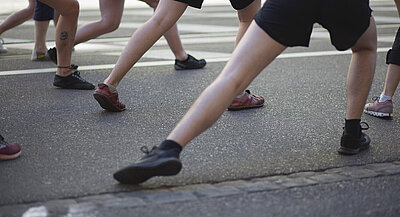Dancing in between Nation-States

Text: Parvathi Ramanathan
Dancer, Researcher and Writer who has occasional morning affairs with poetry
One afternoon recently, I stood among a circle of women coming from different parts of the world, now seeking asylum in Germany. As the facilitator of this session, I invited everyone to share the dance or movement languages that they held in their bodies. Some of the old Afghan women set aside their crutches to show me the graceful movements of Attan. A Syrian woman wearing an abaya tied my scarf low on her waist and busted moves from Raqs Sharqi with full abandon. When we came around to a German lady in our circle who shared some Salsa footwork, I was surprised to hear her say, “Aber eine deutsche Tanzform gibt es sozusagen gar nicht.” (But there really isn’t a German dance form, so to speak).
Berlin draws performance practitioners from all over the world, who have made it their home and their stage. The dance languages of these other lands seep into this city and into this once-divided country. One can sense this abundance in the dance scene here. However, I wonder then, if some of the historical movement practices of this region have gotten denied or left behind in the process? Germany’s history from the Nazi period and its occupation by the Allied Powers led to a kind of corrective cleansing process whose effects may be felt in cultural practices as well. Further along time, the end of the GDR and the quick dismissal of everything East German in the political arena, also denies corporeal knowledge that a significant portion of the citizens of present-day Germany hold. The tendency to easily associate traditional practices with being politically conservative or spießig, may have led to an alienation from specific body-based practices. “Line-dancing is only for the oldies and its too kitsch”, my friend declares, embarrassed of being the winner of the country’s first national-level competition in the form. Of course, there is also a class structure underlying all these positions of dismissal and denial — a desire to express belonging to a political and social spectrum.
In the independent contemporary dance scene today, there is certainly an interest in early twentieth century practices such as Ausdruckstanz, with Valeska Gert’s legacy beginning to be celebrated. There is also abundant research on politicallymotivated invented dances of East Germany, to unpack and comment on the conditions of labour and life in the GDR. Nonetheless, my (limited and incomplete) observation of Berlin’s independent dance scene, finds it to be somewhat self-constrained — constantly in a process of ‘study of’ or ‘resistance against’ its own history. In Berlin, where it sometimes feels as though time has halted for a while; in Berlin, which reaches out to speculative futures in its claims, I wonder if we can create dance that springs off history? Between the traditional Schuhplattler dance and the side-bop moves to Techno-Beats, there are plenty of people’s dances that tread upon the German landscape. At a time when one may seek to dismantle the idea of the nation-state, can we still take inspiration from the land’s corporeal knowledge, and dance in between, across and through nation-states?